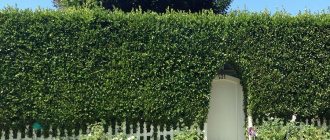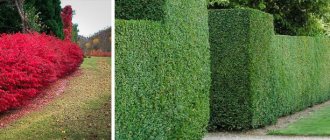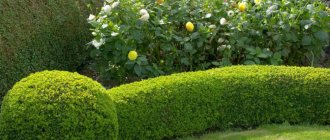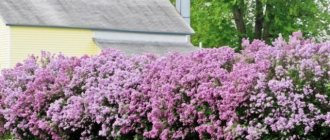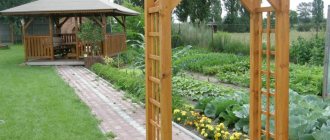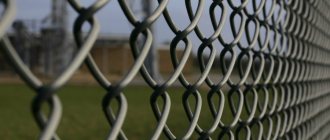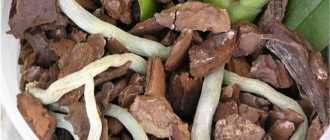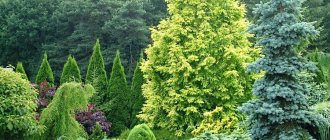Purpose of a hedge
Like a regular hedge, a fence made of living plants performs a restrictive function. Some types of fences, consisting of thorny plant species with a dense crown, are not inferior in reliability to wooden or metal structures. Neither man nor animal can overcome such a wall.
On a note. A solid fence made of deciduous trees, 2-2.5 m high, can significantly reduce the noise level coming from the street. Hedges block polluted air from entering the site, acting as natural filters.
“Living walls” are used to zone a site and camouflage various objects (gazebos, compost heaps, outbuildings). This role is played by decorative varieties of grasses (vines), flowers and shrubs. The perception of the space of the entire site depends on the species composition of the fence, its size and shape.
Additional functions that a hedge successfully copes with:
- attracts birds and beneficial insects to the site;
- serves as a windbreak and keeps snow from being blown out of the area;
- strengthens the soil on slopes, preventing erosion;
- Some plants release healthy phytoncides into the atmosphere.
The installation of hedges allows the gardener to make the appearance of the site unique and protect the interior space from unfavorable external conditions.
Metal structure
A practical and reliable green metal fence is necessarily covered with an anti-corrosion coating that protects the canvas from destruction.
Primer and paint guarantee protection of the metal from the aggressive effects of moisture and natural precipitation; it is better to choose solid and tall structures in light colors and not bright shades.
General requirements for plants
The main feature that unites all crops suitable for planting as a hedge is unpretentiousness. The selection includes seedlings that are drought-resistant, wind-resistant and unpretentious to soil fertility. If the hedge is planted within the city limits, to the specified qualities is added resistance to external pollution: dust and soot settling on the foliage.
Plants should easily tolerate dense planting and regular pruning. Due to thickened planting and intensive cutting, a dense and impenetrable structure of the structure is obtained.
When choosing crops for constructing a hedge “from scratch,” preference is given to fast-growing varieties. A hedge made up of such specimens will reach the required dimensions within 4-6 years after sowing the seeds.
Fast growing shrubs
A fast-growing hedge is obtained from
- privet,
- barberry (varieties of which are both green-leaved and red-leaved, which makes it possible to combine),
- euonymus (valued for the unusual color of its leaves with a border; there are varieties with yellow and green leaves),
- cotoneaster brilliant.
These shrubs form a dense impenetrable barrier, respond well to pruning, do not become bare, and are highly decorative.
Classifications
Hedges are divided into several groups, depending on the height, shape and species composition of the composition. Each group has its own characteristics of care and serves to perform different tasks.
By plants used
According to the type of plants included in the composition, fences are:
- deciduous (dogwood, euonymus, maple, barberry);
- blooming (spirea, lilac, mock orange, rose hips);
- evergreens (conifers);
- climbing (hops, maiden grapes).
There is a practice of creating fences from fruit bushes and trees: currants, gooseberries, cherries, ranetka apple trees. Such a fence, in addition to its protective function, plays the role of a supplier of berries and fruits.
By composition and structure
A hedge can be made up of plants belonging to the same species and variety. This composition is called “uniform”, and is popular in classical and regular gardens.
Combined hedges are planted with plants of different species. Growing up, they imitate the natural landscape, organically combining in height, crown density and foliage color.
Climbing plants are used in the construction of “trellis” structures. Flexible shoots are evenly distributed over the base (metal or plastic mesh, wooden sheathing), intertwining with each other.
By height
Living fences are classified according to height into 4 types:
- border (height up to 40 cm);
- low (up to 100 cm);
- medium (from 100 to 150 cm);
- tall (over 150 cm).
Low and medium fences are made up of shrubs, high fences are made up of trees (oak, linden, maple, lilac).
By planting technique
A living fence can be artificially formed and freely growing.
Using systematic trimming, hedges with a clear crown geometry are created. They look impressive, but require regular pruning throughout their life.
When forming freely, plant branches are not subjected to formative pruning. For this type of fencing, crops with a beautiful natural crown shape are selected. They only require sanitary pruning.
Zoning the site
Is it possible to divide the territory of a personal plot into zones using plants? It is very important to correctly do landscape zoning on the site.
In order to divide it into several zones, you can use small shrubs, the height of which will not exceed two meters. Shrubs of one or more types are suitable for an internal fence.
If you want the bushes to bring not only aesthetic pleasure, you can plant fruits and berries - currants, hawthorn or barberry. Such shrubs will generously provide their owners with delicious fruits.
Boxwood: planting, care, growing in open ground, propagation. Full description of the plant from A to Z. More than 100 photos of evergreen shrubs- Trimming bushes - the basics of choosing the right plants and forming the right shapes, selecting tools (photo + video)
Landscaping a site - basic principles and rules for creating a beautiful site with your own hands
Choosing plants for hedges
The selection of plants for hedges is taken with the utmost seriousness. The appearance, durability and practicality of the fence depend on the correct choice. Should be considered:
- the adaptability of the crop to the climate of the area and the soil on the site;
- seedling growth rate;
- compatibility in appearance and care requirements (for combined plantings).
It is worth deciding on the amount of care that the gardener is willing to provide to the plants. Some species require not only pruning, but also watering and fertilizing.
To arrange a fence you will need not 5-10, but tens, hundreds of plants. Therefore, the cost of seedlings also matters.
Fast growing
A group of shrubs that grow by 20 cm or more per season. Within a few years after sowing seeds or planting seedlings, the plants reach the size of an adult specimen.
The most common types:
- dogwood;
- vesicular carp;
- barberry;
- damson;
- Amur lilac;
- hawthorn;
- hazel (hazel);
- hop;
- grape;
- caragana tree (chiliga);
- sucker;
- irga;
- viburnum;
- mock orange;
- Russian maple;
- rose hip;
- spirea.
6 ways to use old window frames in your country house
Evergreens
A group that retains foliage for a year or longer. The appearance of the fence remains unchanged in winter and summer.
Year-round preservation of foliage is typical for tropical plants that are not able to grow in the domestic climate. In the southern regions of the country, evergreen rhododendrons are cultivated. Ledum retains its greenery and tolerates mild winters well.
Perennial
Almost all plants used for making hedges are perennial. The exception is fast-growing vines (morning glory, Turkish beans, hyacinth beans), which in the Russian climate are grown as an annual crop.
Conifers
Hedges made from coniferous species look impressive and expensive. However, coniferous varieties are more capricious than deciduous ones. In particular, the needles of some species suffer from sunburn in winter, turning yellow and falling off.
The most attractive and resistant to adverse conditions plant is the thuja. Its varieties (western and eastern) tolerate frosty winters well, are drought-resistant and tolerate the gas pollution of a big city. Thuja has an attractive cone-shaped or columnar crown shape, soft and dense needles of bright color. Breeders have created thuja varieties especially for decorative hedges: Smagard, Brabant.
In addition to thujas, spruce, junipers (common, Cossack), fir, cypress (only in the southern regions), and yew are used in the construction of living partitions.
Hardwood
Represented by hundreds of varieties of trees and shrubs. They are unpretentious, frost-resistant, but decorative during the warm season. In winter, deprived of foliage, they do not look attractive.
Curly
They have flexible and long shoots. In some varieties, the shoots are equipped with tendrils to facilitate fastening to a support. The most popular:
- girl's grapes;
- ivy;
- hop;
- climbing rose;
- honeysuckle;
- actinidia;
- clematis;
- wood plier;
- large-leaved kirkazon.
Morning glory and Turkish beans are popular options for creating “green walls” for one season.
Shrubs
Hundreds of species of shrubs are suitable for growing as hedges. Preference is given to unpretentious species with beautiful foliage:
- barberry;
- caragana tree;
- vesicular carp;
- euonymus;
- heather;
- shrubby cinquefoil;
- derain;
- sucker.
Blooming
The following representatives of the flora have bright and long-lasting flowering:
- spirea;
- rose hip;
- lilac;
- mock orange (garden jasmine);
- forsythia;
- rhododendron;
- hydrangea;
- almond;
- action;
- bloodroot;
- budleya David;
- broom.
Fruit bearing
You can combine beauty and benefit in a hedge by planting fruit bushes:
- red and golden currants;
- gooseberry;
- damson;
- felt cherry;
- irga;
- honeysuckle;
- viburnum;
- sea buckthorn;
- barberry;
- japonica;
- blackberries, raspberries.
Trees
With proper care, any unpretentious trees can act as a living fence. Particularly popular are:
- oak;
- elm;
- Linden;
- maple;
- willow;
- Rowan;
- lilac;
- spruce.
Holly holly
You can’t ignore this elegant shrub. In the southern regions, its carved, pointed leaves are completely covered with berries, which turn scarlet closer to winter. This is what Europeans use for New Year's decor.
What is the best material to make a fence from?
Before purchasing seedlings, you need to decide what type of fencing will be. For a free-form composition, several types of trees and shrubs of different sizes are selected. To create strict, cropped forms, species with a dense crown and small foliage are suitable.
It is necessary to study the soil types on the site and know its illumination. Some plants (elion, almond, sea buckthorn) need light sandy soils and bright lighting, others (hydrangea, rose hips) need fertile soils with good moisture.
Flowering shrubs
The best flowering shrubs for hedges are
- hydrangea, prized for its huge balls of flowers ranging from pink to deep blue (the color of the flowers can be adjusted by changing the acidity of the soil),
- mock orange, which fills the garden with an incredible aroma,
- various types of spirea, which differ both in the color of the leaves from green to golden, and in the shape of the bush and flowering,
- common or Hungarian lilac with many shades of lilac.
Planting and care
For planting, choose autumn or spring, regardless of whether seedlings or seeds are used. The soil is freed from weed roots and the necessary additives are added (sand, humus, mineral fertilizers).
Principles of planting placement
Seedlings are planted in a row. The distance between plants in a row is 2 times less than with conventional planting:
- for bushes 30-60 cm;
- in trees 1-1.5 m.
The denser the seedlings grow, the more reliable the fence.
Regular haircut
Plants begin to be cut from the second year after planting. In spring and autumn, sanitary (sick and weak shoots are removed) and formative pruning is carried out. The latter is aimed at giving the hedge a certain shape and enhancing the tillering of plants.
Molded plantings
To give plants a strict geometric shape, special templates are used.
To give the crown density, the main shoots are regularly cut, encouraging dormant side buds to grow. The procedure is carried out up to 2 times per season.
Unshaped hedge
A sanitary haircut twice a year is enough.
Pest and disease protection
Treatment with insecticides and fungicides will help protect plants from diseases and pests. For rot and fungal diseases use: Fufanon, Strobi, Profit Gold.
They will save you from pest invasion: Akarin, Kinmiks, Aktara.
Care Tips
It is better to feed a hedge by spraying it on the leaf.
It is recommended to thin out particularly dense hedges to allow light and air into the crown.
Wooden fences
Wood lumber is painted after arranging the fence, and it is necessary to choose a paint that is sufficiently wear-resistant and will not fade in the sun.
Particular attention is paid to the pre-treatment of lumber with antiseptics and antifungal drugs that protect the wood from rotting and destruction.
Creating a hedge with your own hands at the dacha
To construct a fence of this type, you will need to calculate the number of seedlings based on the length of the fence and the spaces between the plants. To work, you will need a shovel and a cord with stakes to mark the planting row.
Holes are dug in the marked row into which the seedlings are immersed. If necessary, complex fertilizer is applied to the holes. After planting, the bushes are watered abundantly.
If sowing is carried out with seeds, they are placed densely to save space. After germination, excess specimens are replanted.
Hedge ideas
The most popular are hedges made of conifers and deciduous shrubs with lush flowering or variegated foliage.
Mixed
Several types of plants are planted in a row, achieving a harmonious combination of their height and crown structure. Successful combinations:
- Thuja Brabant, red-leaved bladderwort;
- juniper, Thunberg barberry;
- low-growing spirea, thuja or rowan in the background.
Space zoning
For zoning the site, low varieties of shrubs are used: bladderwort, derain, spirea, cinquefoil. Arborvitae and cypress trees are good for creating smooth partitions.
To create secluded “green rooms”, vines and vines are used, braiding supports with them.
"Reliable rear"
The impenetrable fence is grown from caragana, prickly spruce, acacia, hawthorn, rose hips, and thorns. An internal frame made of metal strips will provide additional reliability to the fence.
hedge border
Low-growing fencing is obtained by planting heathers, cinquefoil, and low-growing spirea. During one season, you will enjoy marigolds, chrysanthemums, kochia, cirenaria, petunia, and ornamental cabbage.
"Blooming garden"
For a long-flowering hedge, plants with different flowering periods are selected:
- forsythia, spirea, Japanese quince;
- damson, rose hips, broom;
- lilac, spirea, cinquefoil;
- mahonia, almond, mock orange.
Playing with shapes
For the fence, plants with different crown shapes and foliage structures are selected. Different shapes are obtained by cutting.
Geometric shapes from perennial plants
The crown of the seedlings is given the shape of a cube, ball, parallelepiped, or cone. A combination of figures of different sizes and plants with different crown structures looks impressive. For example:
- cubes made of thuja, cypress and pear;
- a ball of mountain pine, cone-shaped thuja or yew.
"Wavy Fence"
Using pruning, the surface of the green wall is made wavy. Shrubs lend themselves well to shaping: turf, broom, privet.
Blooming wall
Several types of plants are combined in terms of growth and flowering duration. For example: lilac (hawthorn), mock orange (rose hip, viburnum), spirea, cinquefoil, astilbe.
Mix
Fences consisting of plants and additional elements look impressive: wickerwork, stone walls, gabions, decorative trellises.
"Different Ensemble"
Eclecticism is coming into fashion - a combination of shrubs and climbing plants in one row. To these are added spans of picket fence or blind stone fencing.
Improvisation with an old fence
Another durable, but unsightly old fence can be decorated with climbing plants (morning glory, grapes, honeysuckle).
Green wall: growing features
A hedge is a good opportunity for a flight of fancy. For its construction, you can use evergreens, graceful vines, low-growing lush bushes with bright foliage. The choice of design for a green fence depends on a combination of various factors:
- Climatic conditions in the growing region - it is worth initially selecting suitable crops with high winter hardiness for planting. Frost-resistant species do not require special care in severe winter cold.
- The style of the garden landscape - dense living plantings that act as an impenetrable wall, should be consistent with the general style decision in the design of the garden plot.
- The personal desire of the owner is that every gardener is free to choose for his living wall exactly those species that he likes best.
- The purpose of the fence - the selection of seedlings for decorative compositions inside the garden - is fundamentally different from the formation of impenetrable living fences planted along the border of the site.
But all these nuances are worth talking about in more detail.
Photos of hedges
Some examples of successful ideas for hedges.
Creating a hedge on a summer cottage is not an easy, but exciting job. It will take several years from planting the plants to completing the fence. But the finished fence will give the site a unique look.
Red cedar
Juniper virginiana is the second favorite for hedges. Thanks to its small, dense needles, it forms incredibly dense fences. It lends itself well to pruning and retains its shape for a long time, making it ideal for molded hedges.
Common varieties of Virginia juniper:
- “Blue Arrow” - forms a tree of an unusual shape with a pointed arrow, blue needles
- "Glauka" is a tall pyramidal tree with blue-green needles.
